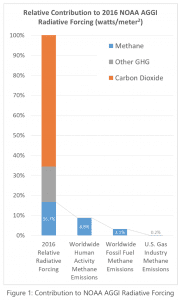 A new white paper developed by GTI’s Center for Methane Research (CMR) addresses questions regarding the impact of atmospheric methane in global warming—technically identified as radiative forcing—and what role fossil fuels play. The paper integrates greenhouse gas radiative forcing data from the National Oceanic and Atmospheric Administration, along with national and international annual greenhouse gas emissions data. The findings provide an estimate of the relative contribution of different methane emission sources to global warming, including worldwide use of fossil fuels and the United States’ use of natural gas.
A new white paper developed by GTI’s Center for Methane Research (CMR) addresses questions regarding the impact of atmospheric methane in global warming—technically identified as radiative forcing—and what role fossil fuels play. The paper integrates greenhouse gas radiative forcing data from the National Oceanic and Atmospheric Administration, along with national and international annual greenhouse gas emissions data. The findings provide an estimate of the relative contribution of different methane emission sources to global warming, including worldwide use of fossil fuels and the United States’ use of natural gas.
GTI launched the CMR consortium in 2016 to serve as a technical information resource on the presence and impacts of methane in the atmosphere, with a focus on the interconnected role of natural gas production, delivery and use. Nearly 20 participant companies have come together to support the CMR on a range of issues related to the real-world impact of methane emissions on climate change.